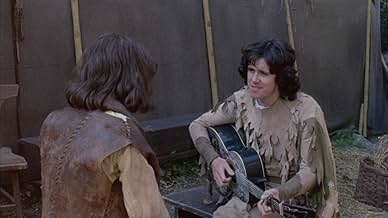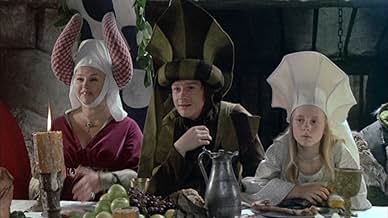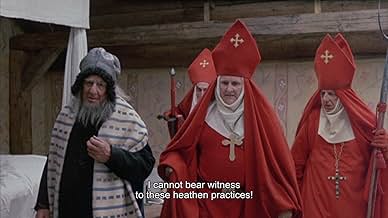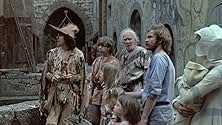IMDb-BEWERTUNG
6,3/10
1006
IHRE BEWERTUNG
Im 14.Jahrhundert wird Deutschland von einer Epidemie des Schwarzen Todes heimgesucht. Ein Flötenspieler mit magischen Kräften kommt in die kleine Stadt Hameln.Im 14.Jahrhundert wird Deutschland von einer Epidemie des Schwarzen Todes heimgesucht. Ein Flötenspieler mit magischen Kräften kommt in die kleine Stadt Hameln.Im 14.Jahrhundert wird Deutschland von einer Epidemie des Schwarzen Todes heimgesucht. Ein Flötenspieler mit magischen Kräften kommt in die kleine Stadt Hameln.
Empfohlene Bewertungen
Back when I was a (allegedly disturbed) young child, "The Pied Piper of Hamelin" was my absolute favorite fairy-tale. I owned many tapes that were filled with bedtime stories and fairy-tales, but I mostly just listened to "The Pied Piper" because it featured fascinatingly morbid topics like the black plague, child abduction, rat infestations and a mysteriously sinister guy playing the flute. I was always convinced the premise of Robert Browning's eerie poem could form the basis of a series of unimaginably dark horror movies, but unfortunately there aren't that many. This British production, filmed on location in Germany, is a pretty great version but it's incredibly obscure for some reason and I spent an awful long time purchasing a decent copy. Now that I finally own it, I'm both thrilled about re-experiencing the familiar story lines as well as surprised about discovering entirely new story aspects I wasn't even aware of. The new (to me, at least) elements mostly handle about political and religious hypocrisy, so I presume that is the reason why they weren't included in any of the fairy-tale versions I grew up with. But it remains a fascinating story and a fabulously engaging film, only suffering from obvious and regrettable budget restrictions. Director and co-writer Jacques Demy had a clear and personal vision of the story, and it's definitely not a movie for young children to watch. Although never graphic or repulsive, "The Pied Piper" thrives on a disturbing atmosphere and it never evades any controversial themes, like the abuse of political power by the Catholic Church and the arranged marriages with minors. Donovan is excellent as the Piper, passing through Hamelin with a family of traveling circus artists. The burgomaster and the Baron (another splendid role for versatile super-actor Donald Pleasance) supposedly run the secluded little town, but they mainly obey the will of the uncanny red monks that always look over their shoulders. The friendly Jewish alchemist Melius is concerned about a threatening outbreak of the Bubonic plague, the power-hungry son of the Baron (John Hurt) is about to wed the under-aged burgomaster's daughter for financial reasons and the Pied Piper is the only person capable of freeing the town from its rat infestation. The script of this film is well filled and requires your absolute full attention, but the elaboration of the different story lines is highly compelling and the dialogs are enchanting. The costume designs and scenery are terrific and genuinely take you back to the dark and unsettling medieval times. Donovan, primarily a singer, also provides the film with a couple of great songs (most notably "They Call me the Pied Piper" and "Life has its ups and downs") and there are at least two near-brilliant and unforgettable sequences. Namely the rats breaking out of the wedding cake and a harrowing execution scene near the end. If you own "The Pied Piper", it's definitely a film to treasure.
Grimm Brothers tale of a strolling minstrel in 1349 Germany who agrees to rid the village of Hamelin of plague-carrying rats is given a serious, perhaps overly-solemn treatment. Jacques Demy has directed the story in a straightforward fashion, without any humor or playfulness, mystery or beauty (with the exception of the sunrise-heightened finale). Pop singer Donovan is well-cast in the title role, and his music compositions are good even if his songs are not of the Medieval period. The other cast members--top-billed Jack Wild, Donald Pleasance and John Hurt--have very little to do; Wild, in particular, is forced to painfully hobble around with a crutch as an alchemist's assistant. Michael Hordern as Melius, who is unable to conjure a cure for the Black Death and is arrested for being a heretic, gives the picture's finest performance, though his final moment tied to a stake may prove to be too heavy for the movie's supposed 'family audience.' The dank, mildewy locations, period costumes and bedraggled extras all lend a convincing air to the film, but "Piper"'s downbeat nature (not to mention all those rats!) makes it a tough sell. ** from ****
The Pied Piper of Hamelin (also known as the Pan Piper or the Rat-Catcher of Hamelin) is the title character of a legend from the town of Hamelin (Hameln), Lower Saxony, Germany. The Pied Piper uses his musical talents to lure the pesky rodents away from a small German town. The legend dates back to the Middle Ages, the earliest references describing a piper, dressed in multicolored ("pied") clothing, who was a rat catcher hired by the town to lure rats away with his magic pipe. When the citizens refuse to pay for this service as promised, he retaliates by using his instrument's magical power on their children, leading them away as he had the rats. This version of the story spread as folklore and has appeared in the writings of Johann Wolfgang von Goethe, the Brothers Grimm, and Robert Browning, among others. The phrase "pied piper" has become a metaphor for a person who attracts a following through charisma or false promises. Our starring (Donovan) goes in search of fortune, equipped only with his inseparable guitar on his back. He stumbles upon a family of strolling players and a Jew alchemist called Melius (Michael Hordern) and his supporter , a teen (Jack Wild) , who helps him attain success and notoriety in a town called Hamelin . But rats invading Hamelin in droves; a magical piper, whose music only children (and rats) can hear, strikes a bargain...which, once the rats are gone, the Mayor and council renege on, to their subsequent regret. Come children of the universe, let Donovan take you away, far far away. Now! A giant color spectacle! From the pages of the immortal classics comes this famous story!.. The Enchanting Musical Version of The Pied Piper of Hamelin. A film classic for children. No rats in Hamelin! Just us adorable white mice kids'll love...
Known and classic story about a medieval town overwhelmed by rats, a medieval town hires a magical piper who can rid the town of the pest in exchange for gold but the crooked mayor has no intention of honoring the deal . This rendition The Pied Piper(1972) contains a sour critique to ambition , corruption, intolerance, racism ignorance, stupidity, and bigotry . Originally produced by David Puttman , this interesting picture boasts of a fabulous British cast with known actors such as John Hurt , Michael Hordern Peter Eyre , Jack Wild, David Leland , Roy Kinnear , Keith Buckley and Donald Pleasence . Agreeable songs by Donovan as the musician who leads away the town's rodents, and children, with his music in this rock and roll adaptation of The Pied Piper of Hamelin. The motion picture was well directed by Jacques Demy., though this adaptation isn't for kiddies due to its disturbing and grim events.
There are many contradictory theories about the Pied Piper. Some suggest he was a symbol of hope to the people of Hamelin, which had been attacked by plague; he drove the rats from Hamelin, saving the people from the epidemic. A number of theories suggest that children died of some natural causes such as disease or starvation, and that the Piper was a symbolic figure of Death. Analogous themes which are associated with this theory include the Dance of Death, Totentanz or Danse Macabre, a common medieval trope. Some of the scenarios that have been suggested as fitting this theory include that the children drowned in the river Weser, were killed in a landslide or contracted some disease during an epidemic. Another modern interpretation reads the story as alluding to an event where Hamelin children were lured away by a pagan or heretic sect to forests near Coppenbrügge (the mysterious Koppen "hills" of the poem) for ritual dancing where they all perished during a sudden landslide or collapsing sinkhole .
There're several renditions about this classy fairy-tale : The Pied Piper (1942) by Irving Pichel with Monty Woolley , Roddy McDowall , Anne Baxter, Otto Preminger. The Pied Piper of Hamelin (1957) by Bretaigne Windust with Van Johnson , Claude Rains, Lori Nelson , Jim Backus. Hamelin (1969) by Luis Maria Delgado with Miguel Ríos , Roberto Camardiel, Luchy Soto , Margaret Peters , Matilde Muñoz Sampedro.
Known and classic story about a medieval town overwhelmed by rats, a medieval town hires a magical piper who can rid the town of the pest in exchange for gold but the crooked mayor has no intention of honoring the deal . This rendition The Pied Piper(1972) contains a sour critique to ambition , corruption, intolerance, racism ignorance, stupidity, and bigotry . Originally produced by David Puttman , this interesting picture boasts of a fabulous British cast with known actors such as John Hurt , Michael Hordern Peter Eyre , Jack Wild, David Leland , Roy Kinnear , Keith Buckley and Donald Pleasence . Agreeable songs by Donovan as the musician who leads away the town's rodents, and children, with his music in this rock and roll adaptation of The Pied Piper of Hamelin. The motion picture was well directed by Jacques Demy., though this adaptation isn't for kiddies due to its disturbing and grim events.
There are many contradictory theories about the Pied Piper. Some suggest he was a symbol of hope to the people of Hamelin, which had been attacked by plague; he drove the rats from Hamelin, saving the people from the epidemic. A number of theories suggest that children died of some natural causes such as disease or starvation, and that the Piper was a symbolic figure of Death. Analogous themes which are associated with this theory include the Dance of Death, Totentanz or Danse Macabre, a common medieval trope. Some of the scenarios that have been suggested as fitting this theory include that the children drowned in the river Weser, were killed in a landslide or contracted some disease during an epidemic. Another modern interpretation reads the story as alluding to an event where Hamelin children were lured away by a pagan or heretic sect to forests near Coppenbrügge (the mysterious Koppen "hills" of the poem) for ritual dancing where they all perished during a sudden landslide or collapsing sinkhole .
There're several renditions about this classy fairy-tale : The Pied Piper (1942) by Irving Pichel with Monty Woolley , Roddy McDowall , Anne Baxter, Otto Preminger. The Pied Piper of Hamelin (1957) by Bretaigne Windust with Van Johnson , Claude Rains, Lori Nelson , Jim Backus. Hamelin (1969) by Luis Maria Delgado with Miguel Ríos , Roberto Camardiel, Luchy Soto , Margaret Peters , Matilde Muñoz Sampedro.
Donovan sings three songs :outside the wonderful "sailing homeward",he performs two ditties "I'm the pied piper" (obvious) and "life has her (!) ups and her downs".It was filmed on location in Germany
"The pied piper" ,like "Peau d'âne" which was released the year before, is a fairy tale ,but the mood is drastically different:I would say that "peau d'âne" is a movie for children that can appeal to adults,and "the pied piper" a movie for grown -ups which can appeal to children."Peau d'âne" is the bright Renaissance,with its châteaux de la Loire such as Chambord,and the forest and the country are not hostile,it's a providential world."The pied piper" is the dark Middle Ages;the beginning might have been influenced by Bergman's "the seventh seal":the wandering entertainers ,the plague ,the "sorcerer" ...The screen play is almost an original one:the famous legend lasts barely ten minutes ,the rest of the plot is completely new and extremely pertinent.
Two worlds clash in Demy's work: the world of Melius the jew,that of an embryonic science and a desire to explain the things and to react to them:he comes much too soon and anyway the Jews suffered persecutions in those troubled times too:think that Louis IX,King of France of the thirteenth century ,forced the jews to wear the "rouelle",a sinister ancestor of Hitler's yellow star.And he became Saint-Louis, canonized by the Catholic Church.
And there's the world of the bishops,sinister characters dressed in red,red as blood,who personify intolerance and ignorance :unlike Melius,they react to the bubonic plague by saying it's a God-sent ordeal,because men are sinners,they do not have to understand but they must be ready to repent and to mortify (self-flagellation).The wedding is revealing as well:listen to the bishop,the way he speaks to the bride:she is an impure human being,whose only way is to follow her husband's rule:till 1215,woman had no soul!
Demy expresses his disgust with the famous scene of the wedding cake: big rats appear,they had entered the cathedral-pastry.It won't be long before the magnificent dessert crumble .And it will not be long before Hamelin itself and its hypocrite priests crumble like Sodom .So the pied piper is like God's angel ,leading Lot out of this doomed place.The children are the just men,sometimes sacrified as Hurt's unfortunate bride ,a child herself -a girl used to get married at an early age in those ancient times.
Demy 's pessimism,which passed for melancholy in "Lola" , muted in "les parapluies de Cherbourg",seemed to disappear in "les demoiselles de Rochefort" and "peau d'âne", is glaring in "the pied piper".This is probably his darkest work.Thus ,one can forget his return to the ponderous comedy with Deneuve and Mastroianni in 1972".
"The pied piper" remains an overlooked,ignored work.How many Demy's fans do not even know that this film exists?I urge them to see it,it's an essential part of his work,and maybe his swansong,because he was never to reach such heights afterward.
"The pied piper" ,like "Peau d'âne" which was released the year before, is a fairy tale ,but the mood is drastically different:I would say that "peau d'âne" is a movie for children that can appeal to adults,and "the pied piper" a movie for grown -ups which can appeal to children."Peau d'âne" is the bright Renaissance,with its châteaux de la Loire such as Chambord,and the forest and the country are not hostile,it's a providential world."The pied piper" is the dark Middle Ages;the beginning might have been influenced by Bergman's "the seventh seal":the wandering entertainers ,the plague ,the "sorcerer" ...The screen play is almost an original one:the famous legend lasts barely ten minutes ,the rest of the plot is completely new and extremely pertinent.
Two worlds clash in Demy's work: the world of Melius the jew,that of an embryonic science and a desire to explain the things and to react to them:he comes much too soon and anyway the Jews suffered persecutions in those troubled times too:think that Louis IX,King of France of the thirteenth century ,forced the jews to wear the "rouelle",a sinister ancestor of Hitler's yellow star.And he became Saint-Louis, canonized by the Catholic Church.
And there's the world of the bishops,sinister characters dressed in red,red as blood,who personify intolerance and ignorance :unlike Melius,they react to the bubonic plague by saying it's a God-sent ordeal,because men are sinners,they do not have to understand but they must be ready to repent and to mortify (self-flagellation).The wedding is revealing as well:listen to the bishop,the way he speaks to the bride:she is an impure human being,whose only way is to follow her husband's rule:till 1215,woman had no soul!
Demy expresses his disgust with the famous scene of the wedding cake: big rats appear,they had entered the cathedral-pastry.It won't be long before the magnificent dessert crumble .And it will not be long before Hamelin itself and its hypocrite priests crumble like Sodom .So the pied piper is like God's angel ,leading Lot out of this doomed place.The children are the just men,sometimes sacrified as Hurt's unfortunate bride ,a child herself -a girl used to get married at an early age in those ancient times.
Demy 's pessimism,which passed for melancholy in "Lola" , muted in "les parapluies de Cherbourg",seemed to disappear in "les demoiselles de Rochefort" and "peau d'âne", is glaring in "the pied piper".This is probably his darkest work.Thus ,one can forget his return to the ponderous comedy with Deneuve and Mastroianni in 1972".
"The pied piper" remains an overlooked,ignored work.How many Demy's fans do not even know that this film exists?I urge them to see it,it's an essential part of his work,and maybe his swansong,because he was never to reach such heights afterward.
I had seen this one ages ago on local TV, back in the early 1980s when our set was still in black-and-white! Naturally, I welcomed Paramount’s idea to let Legend Films release it on DVD albeit bare-bones, and I luckily happened upon it in (arguably) Malta’s best-stocked DVD rental store when it comes to vintage Hollywood movies.
I’ve been a fan of Fairy Tales every since early childhood when illustrated Maltese translations of the Brothers Grimm’s famous stories where constant companions during the Summer holidays and, when my main interest migrated to film, I eagerly sought out examples of this type. The French seemed to do the genre particularly well – Ladislaw Starewicz’s delightful pioneering puppet classic THE TALE OF THE FOX (1931), Jean Cocteau’s enchanting LA BELLE ET LA BETE (1946) and the charming animated fable LE ROI ET L’OISEAU (1979). Jacques Demy also tried his hand at this by bringing DONKEY SKIN (1970) to the screen with Catherine Deneuve, Jacques Perrin, Jean Marais and Delphine Seyrig. In fact, THE PIED PIPER was his next project and follows similar lines – even if it’s a British production shot in Germany, though still with an equally remarkable cast: Jack Wild, Donald Pleasence, John Hurt, Michael Hordern, Peter Vaughan, Roy Kinnear, Diana Dors and, in the titular role, folk singer Donovan! The general consensus about Demy is that his career peaked early (late 1960s) and progressed engagingly but unremarkably towards an untimely end (early 1990s); actually, I haven’t seen any of his acknowledged masterpieces yet – I do own THE UMBRELLAS OF CHERBOURG (1964) on R2 DVD, though, and also have the ultra-rare LADY Oscar (1979) in my unwatched pile.
While Maltin gives this version of THE PIED PIPER (incidentally, the 1957 TV-film with Van Johnson and Claude Rains is also available for rental over here) a very generous , most other reviews of the film I’ve come across were usually mixed and less enthusiastic. In fact, I’d say that its unexpectedly grim tone got to be a bit much at times and left one with a sour taste in the mouth; besides, in spite of Demy’s detached approach (with very few close-ups throughout), the whole still felt somewhat claustrophobic. Even so, the actors, the décor, the costumes and the music eventually save the day: Wild has probably his most significant role after OLIVER! (1968) as Jewish alchemist Hordern’s lame assistant; Pleasence and Hurt are truly despicable as greedy father and son and the town’s chief citizens; Kinnear and Dors as the burgomaster and his wife who want to marry off their teenage offspring (Cathy Harrison, Rex’s daughter) to Hurt; Peter Vaughan is a bloodthirsty Bishop who eventually has Hordern burned alive at the stake.
The troupe of traveling players in a plague-ridden medieval town cannot help but raise comparisons with Ingmar Bergman’s THE SEVENTH SEAL (1957), while the onslaught of the rats (at one point coming out of the wedding cake!) might well have influenced a similar scene in Werner Herzog’s NOSFERATU THE VAMPYRE (1979). Finally, Donavan’s score is pleasant if not quite memorable – his performance is equally decent even if, the film’s title notwithstanding, he is not really the main character!
I’ve been a fan of Fairy Tales every since early childhood when illustrated Maltese translations of the Brothers Grimm’s famous stories where constant companions during the Summer holidays and, when my main interest migrated to film, I eagerly sought out examples of this type. The French seemed to do the genre particularly well – Ladislaw Starewicz’s delightful pioneering puppet classic THE TALE OF THE FOX (1931), Jean Cocteau’s enchanting LA BELLE ET LA BETE (1946) and the charming animated fable LE ROI ET L’OISEAU (1979). Jacques Demy also tried his hand at this by bringing DONKEY SKIN (1970) to the screen with Catherine Deneuve, Jacques Perrin, Jean Marais and Delphine Seyrig. In fact, THE PIED PIPER was his next project and follows similar lines – even if it’s a British production shot in Germany, though still with an equally remarkable cast: Jack Wild, Donald Pleasence, John Hurt, Michael Hordern, Peter Vaughan, Roy Kinnear, Diana Dors and, in the titular role, folk singer Donovan! The general consensus about Demy is that his career peaked early (late 1960s) and progressed engagingly but unremarkably towards an untimely end (early 1990s); actually, I haven’t seen any of his acknowledged masterpieces yet – I do own THE UMBRELLAS OF CHERBOURG (1964) on R2 DVD, though, and also have the ultra-rare LADY Oscar (1979) in my unwatched pile.
While Maltin gives this version of THE PIED PIPER (incidentally, the 1957 TV-film with Van Johnson and Claude Rains is also available for rental over here) a very generous , most other reviews of the film I’ve come across were usually mixed and less enthusiastic. In fact, I’d say that its unexpectedly grim tone got to be a bit much at times and left one with a sour taste in the mouth; besides, in spite of Demy’s detached approach (with very few close-ups throughout), the whole still felt somewhat claustrophobic. Even so, the actors, the décor, the costumes and the music eventually save the day: Wild has probably his most significant role after OLIVER! (1968) as Jewish alchemist Hordern’s lame assistant; Pleasence and Hurt are truly despicable as greedy father and son and the town’s chief citizens; Kinnear and Dors as the burgomaster and his wife who want to marry off their teenage offspring (Cathy Harrison, Rex’s daughter) to Hurt; Peter Vaughan is a bloodthirsty Bishop who eventually has Hordern burned alive at the stake.
The troupe of traveling players in a plague-ridden medieval town cannot help but raise comparisons with Ingmar Bergman’s THE SEVENTH SEAL (1957), while the onslaught of the rats (at one point coming out of the wedding cake!) might well have influenced a similar scene in Werner Herzog’s NOSFERATU THE VAMPYRE (1979). Finally, Donavan’s score is pleasant if not quite memorable – his performance is equally decent even if, the film’s title notwithstanding, he is not really the main character!
Wusstest du schon
- WissenswertesThe film was considered too dark for a children's film.
- VerbindungenFeatured in Jacquot de Nantes (1991)
Top-Auswahl
Melde dich zum Bewerten an und greife auf die Watchlist für personalisierte Empfehlungen zu.
- How long is The Pied Piper?Powered by Alexa
Details
- Erscheinungsdatum
- Herkunftsländer
- Offizieller Standort
- Sprachen
- Auch bekannt als
- The Pied Piper
- Drehorte
- Produktionsfirmen
- Weitere beteiligte Unternehmen bei IMDbPro anzeigen
Zu dieser Seite beitragen
Bearbeitung vorschlagen oder fehlenden Inhalt hinzufügen

Oberste Lücke
By what name was Der Rattenfänger von Hameln (1972) officially released in India in English?
Antwort




























